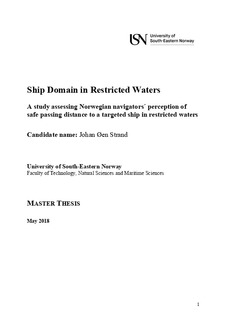Ship Domain in Restricted Waters : A study assessing Norwegian navigators´ perception of safe passing distance to a targeted ship in restricted waters
Master thesis
Permanent lenke
http://hdl.handle.net/11250/2638442Utgivelsesdato
2018Metadata
Vis full innførselSamlinger
Sammendrag
Collisions at sea is a great threat to the navigational safety. To assess the navigational
safety, navigators of ships make use of various criteria. The most commonly adopted ones are
two proximity indicators called Closest Point of Approach and Time to Closest Point of
Approach. Research suggests that these are insufficient for their intended purpose and
generally require a lot of experience from any one applying them, especially in restricted and
congested waters. A concept termed ship domain offers an intuitive alternative. The concept
is concerned with defining a free space around a ship required for safe navigation and
collision avoidance and thus it is a concept aiming at generalizing safe distance. The general
problem is that the ship domain is heavily dependent on certain factors known to influence its
shape and size, three of which are the type water area, relative bearing to an approaching
targeted ship and the own ship´s size. This thesis have investigated the influence of these
factors on the ship domain shape and size as perceived by Norwegian navigators in restricted
waters in a quantitative, quasi-experimental, questionnaire-based study. It was found, with
some caution due to a small sample size, that navigators perceived a ship domain in an
increasing manner depending on ship size. The overall influence of ship size on the mean ship
domain size could be approximated by a linear regression. The ship domain shape resembled
a circle regardless of ship size. It was also found that the relative bearing of a targeted ship
had an impact on a perceived safe passing distance. However, there was found no wider
systematic differences corresponding to past research and hence some discussion follows this.
Finally, future research should consider an empirical approach that considers actual ship
navigation so that the results in this thesis can be confirmed. It is also recommended that
future research considers a mixed method approach that allows probing for additional
information, electing how navigators assess the ship domain.
